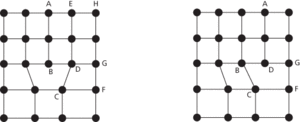A crystal lattice is formed by a repeated arrangement of atoms, ions, or molecules. Within 1 cubic centimetre of material one can expect to find up to 1022 atoms and it is extremely unlikely that all of these will be arranged in perfect order. Some atoms will not be exactly in the right place, with the result that the lattice will contain defects. The presence of defects within the crystal structure has profound consequences for certain bulk properties of the solid, such as the electrical resistance and the mechanical strength.
Point defects
Local crystal defects, called point defects, appear as either impurity atoms or gaps in the lattice. Impurity atoms can occur in the lattice either at interstitial sites (between atoms in a nonlattice site) or at substitutional sites (replacing an atom in the host lattice). Lattice gaps are called vacancies and arise when an atom is missing from its site in the lattice. Vacancies are sometimes called Schottky defects. A vacancy in which the missing atom has moved to an interstitial position is known as a Frenkel defect.
Colour centres
In ionic crystals, the ions and vacancies always arrange themselves so that there is no build-up of one type of charge in any small volume of the crystal. If ions or charges are introduced into or removed from the lattice, there will, in general, be an accompanying rearrangement of the ions and their outer valence electrons. This rearrangement is called charge compensation and is most dramatically observed in colour centres. If certain crystals are irradiated with X-rays, gamma rays, neutrons, or electrons a colour change is observed. For example, diamond may be coloured blue by electron bombardment and quartz may be coloured brown by irradiation with neutrons. The high-energy radiation produces defects in the lattice and, in an attempt to maintain charge neutrality, the crystal undergoes some measure of charge compensation. Just as electrons around an atom have a series of discrete permitted energy levels, so charges residing at point defects exhibit sets of discrete levels, which are separated from one another by energies corresponding to wavelengths in the visible region of the spectrum. Thus light of certain wavelengths can be absorbed at the defect sites, and the material appears to be coloured. Heating the irradiated crystal can, in many cases, repair the irradiation damage and the crystal loses its coloration.
Dislocations
Nonlocal defects may involve entire planes of atoms. The most important of these is called a dislocation. Dislocations are essentially line defects; that is, there is an incomplete plane of atoms in the crystal lattice. In 1934, Geoffrey Ingram Taylor, Egon Orowan, and Michael Polanyi independently proposed the concept of the dislocation to account for the mechanical strength of metal crystals. Their microscopic studies revealed that when a metal crystal is plastically deformed, the deformation does not occur by a separation of individual atoms but rather by a slip of one plane of atoms over another plane. Dislocations provide a mechanism for this slipping of planes that does not require the bulk movement of crystal material. The passage of a dislocation in a crystal is similar to the movement of a ruck in a carpet. A relatively large force is required to slide the carpet as a whole. However, moving a ruck over the carpet can inch it forward without needing such large forces. This movement of dislocations is called plastic flow.

Point defects in a two-dimensional crystal.
Strength of materials
In practice most metal samples are polycrystalline; that is they consist of many small crystals or grains at different angles to each other. The boundary between two such grains is called a grain boundary. The plastic flow of dislocations may be hindered by the presence of grain boundaries, impurity atoms, and other dislocations. Pure metals produced commercially are generally too weak to be of much mechanical use. The weakness of these samples can be attributed to the ease with which the dislocations are able to move within the sample. Slip, and therefore deformation, can then occur under relatively low stresses. Impurity atoms, other dislocations, and grain boundaries can all act as obstructions to the slip of atomic planes. Traditionally, methods of making metals stronger involved introducing defects that provide regions of disorder in the material. For example, in an alloy, such as steel, impurity atoms (e.g. carbon) are introduced into the lattice during the forging process. The perfection of the iron lattice structure is disturbed and the impurities oppose the dislocation motion. This makes for greater strength and stiffness.
The complete elimination of dislocations may seem an obvious way to strengthen materials. However, this has only proved possible for hair-like single-crystal specimens called whiskers. These whiskers are only a few micrometres thick and are seldom more than a few millimetres long; nevertheless their strength approaches the theoretical value.

Point defects in a two-dimensional crystal. The extra plane of atoms AB causes strain at bond CD. On breaking, the bond flips across to form CB. This incremental movement shifts the dislocation across so that the overall effect is to slide the two planes BDG and CF over
- methyl acetate
- methyl alcohol
- methylamine
- methylated spirits
- methylation
- methylbenzene
- methyl bromide
- methyl chloride
- methyl cyanide
- methylene
- methylene blue
- methylene chloride
- methylenedioxymethamphetamine
- methyl ethanoate
- methyl ethyl ketone
- methyl group
- methylidyne
- methyl methacrylate
- methylome
- methyl orange
- methylphenols
- methyl red
- methyl violet
- methylxanthines
- Metis